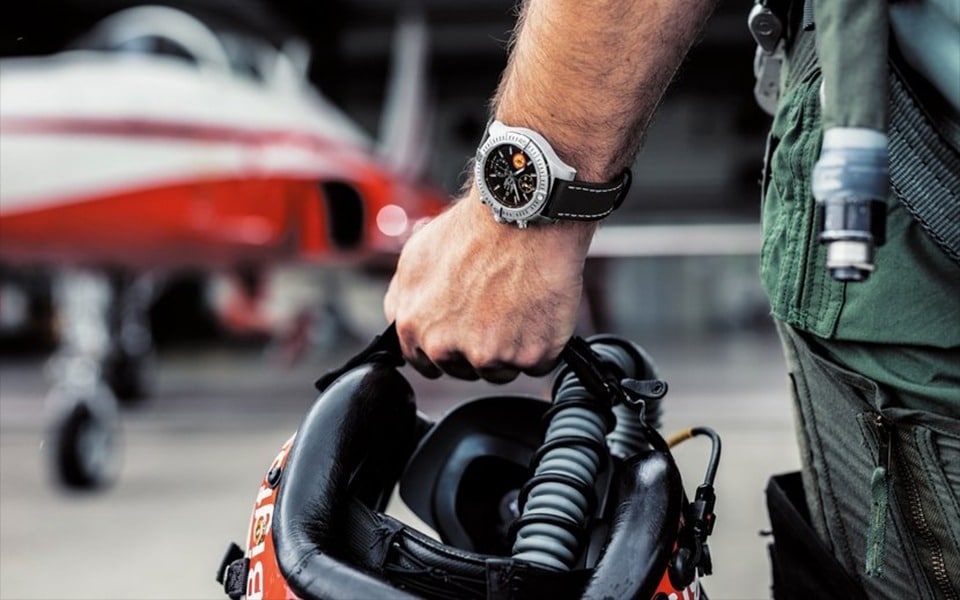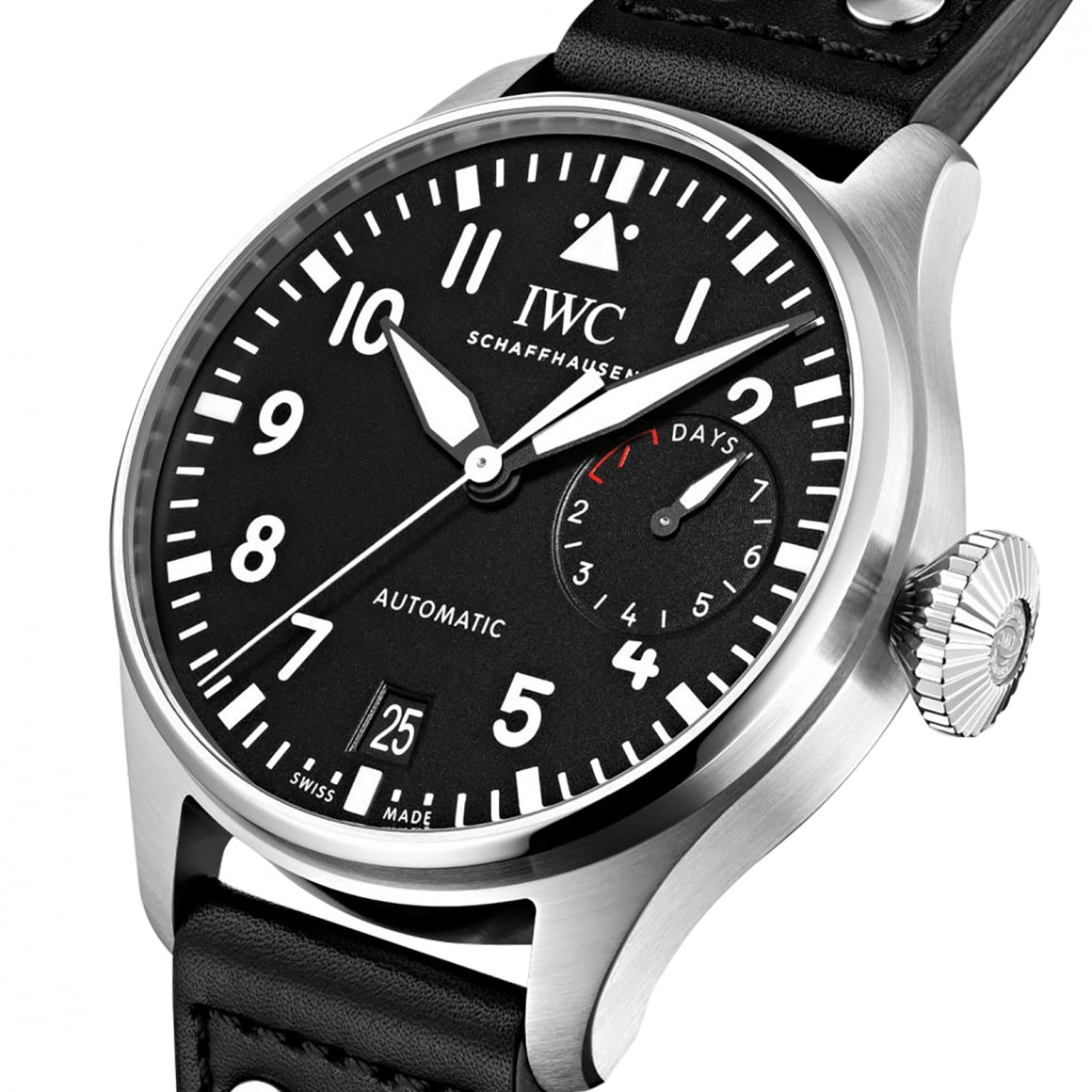The Complete Calibre Guide To Pilot Watches
By Sarah Jayne Potter | 6 minute read

There’s something inherently awe-inspiring about pilot watches. Originally crafted for those on the search for adventure in the skies, these timepieces continue to command attention and capture imagination like no other.
Both luxury watches and flying are seemingly entwined. The golden age of aviation, featuring pilots with leather flying jackets and thick goggles soaring through the clouds, is a fabled tale. As romantic as that of luxury timepieces being meticulously crafted in a quaint atelier against a backdrop of snow-capped Swiss mountains.
In this guide we’ll be taking a look at what defines a pilot watch, the history behind them, and how to choose one that’s most suited for you.
In this guide we’ll be taking a look at what defines a pilot watch, the history behind them, and how to choose one that’s most suited for you.

What is a pilot watch?
Pilot watches were originally designed to provide convenience and support to those undertaking the daring pursuit of aviation. Computers in the cockpit simply didn’t exist back in the day, and so pilots turned to the wristwatch as a practical tool in which to help them with things like calculating their distance traveled and fuel burn, as well as timing events. Since then, the pilot watch’s evolution in both style and technology has earned it a place as an essential bit of kit for pilots, travellers, and those appreciative of an effortlessly stylish and masculine aesthetic.
To remain elegant yet robust and efficient is no small feat, but the pilot watch achieves it with ease. Their size and simplicity is down to the pilots of the time needing to use it, all while navigating an aircraft and wearing large gloves. Nowadays, it’s exactly this allure that has made it iconic. No longer only for those flying thousands of feet above sea level, pilot watches hold a charm that appeals to first-time watch buyers and fully fledged aficionados alike.
Pilot watches were originally designed to provide convenience and support to those undertaking the daring pursuit of aviation. Computers in the cockpit simply didn’t exist back in the day, and so pilots turned to the wristwatch as a practical tool in which to help them with things like calculating their distance traveled and fuel burn, as well as timing events. Since then, the pilot watch’s evolution in both style and technology has earned it a place as an essential bit of kit for pilots, travellers, and those appreciative of an effortlessly stylish and masculine aesthetic.
To remain elegant yet robust and efficient is no small feat, but the pilot watch achieves it with ease. Their size and simplicity is down to the pilots of the time needing to use it, all while navigating an aircraft and wearing large gloves. Nowadays, it’s exactly this allure that has made it iconic. No longer only for those flying thousands of feet above sea level, pilot watches hold a charm that appeals to first-time watch buyers and fully fledged aficionados alike.
The history behind the pilot watch
From visionary innovators the Wright brothers, to steadfast pioneer Ameila Earhart, the history of aviation is steeped in legend and admiration. Each accomplishment a coming together of ambition and engineering excellence. Not too dissimilar then to the innovative heritage of luxury timepieces.
Timepieces first took to the skies at the very start of the twentieth century, where in 1906, Alberto Santos-Dumont achieved the coveted accomplishment of the first flight to take off under its own power. During this time, Santos-Dumont complained to long-time friend Louis Cartier that the pocket watch was proving to be too impractical for flight. Inspiration soared and Cartier created the first example of a pilot watch, the Cartier-Santos.
Since then, timepieces have been on board during many pivotal moments in world history. From Louis Blériot becoming the first man to fly across the English Channel, while wearing a Zenith timepiece, to the scores of World War II pilots whose need for precision and performance dictated many of the features we still see today.
Take a more comprehensive voyage into the history of the pilot watch.
From visionary innovators the Wright brothers, to steadfast pioneer Ameila Earhart, the history of aviation is steeped in legend and admiration. Each accomplishment a coming together of ambition and engineering excellence. Not too dissimilar then to the innovative heritage of luxury timepieces.
Timepieces first took to the skies at the very start of the twentieth century, where in 1906, Alberto Santos-Dumont achieved the coveted accomplishment of the first flight to take off under its own power. During this time, Santos-Dumont complained to long-time friend Louis Cartier that the pocket watch was proving to be too impractical for flight. Inspiration soared and Cartier created the first example of a pilot watch, the Cartier-Santos.
Since then, timepieces have been on board during many pivotal moments in world history. From Louis Blériot becoming the first man to fly across the English Channel, while wearing a Zenith timepiece, to the scores of World War II pilots whose need for precision and performance dictated many of the features we still see today.
Take a more comprehensive voyage into the history of the pilot watch.

Additional bezel markings
Having a range of additional markings on the bezel allows pilots to make any necessary calculations while in the air. From fuel burn to wind correction angles, this is an integral feature.
A large crown
This tends to be a traditional feature owing to its necessity back in the day, when pilot’s wore huge gloves and would need to wind the crown without removing them. While aviation has moved on and removed the need for gloves, this feature remains as an aesthetic choice.
A large, legible dial
One of the key components behind the innovation of the pilot watch remains a fundamental feature today. The need to see the dial clearly and quickly. You’ll find large dials with high-contrast numbers and hands that can easily be seen in the dark. This luminosity makes it easy to obtain information during night flights and are some of a pilot watch’s principal features.
Dual-time functionality
Crossing time zones comes with a need to track both local and destination time. Using an additional hand gives the timepiece a dual-time functionality, displaying two time zones at once.
Riveted leather straps
It comes as no surprise that a pilot requires straps which are robust and durable. During the Second World War, wearing a watch over a flight jacket meant long straps were vital. Then, to keep them firmly in place, two metal rivets were secured on each side of the strap, with a single rivet at the opposite end. Rivets do remain nowadays however, they tend to be in homage and purely for aesthetics.
There are also specific luxury watch materials that are used time and again for pilot watches. These include leather and rubber for straps, thanks to their high quality and durability, and a crystal that is made from sapphire, as these provide scratch resistance and are anti-reflective and shatter-proof.
It comes as no surprise that a pilot requires straps which are robust and durable. During the Second World War, wearing a watch over a flight jacket meant long straps were vital. Then, to keep them firmly in place, two metal rivets were secured on each side of the strap, with a single rivet at the opposite end. Rivets do remain nowadays however, they tend to be in homage and purely for aesthetics.
There are also specific luxury watch materials that are used time and again for pilot watches. These include leather and rubber for straps, thanks to their high quality and durability, and a crystal that is made from sapphire, as these provide scratch resistance and are anti-reflective and shatter-proof.

With a big crown, rivets on the strap, and a large, clear dial, the IWC Big Pilot’s Watch IW501001 featured above, embodies the key features of a pilot watch.
Choosing the right pilot watch
Our advice for choosing a pilot watch is exactly the same as choosing a luxury watch. Set a budget, research extensively, and take your time. You’re perhaps in a more desirable position than some searching for a timepiece, as you already know which style is right for you.
The characteristics and aesthetics of a pilot watch make them a practical timepiece that’s in keeping with a casual, smart-casual, or business-casual style. You’ve also got the status of a watch that comes with such a spirited history.
Thanks to their rich history of innovation and craftsmanship of pilot watches, Breitling and IWC Schaffhausen are two excellent brands to begin your search with.
Our advice for choosing a pilot watch is exactly the same as choosing a luxury watch. Set a budget, research extensively, and take your time. You’re perhaps in a more desirable position than some searching for a timepiece, as you already know which style is right for you.
The characteristics and aesthetics of a pilot watch make them a practical timepiece that’s in keeping with a casual, smart-casual, or business-casual style. You’ve also got the status of a watch that comes with such a spirited history.
Thanks to their rich history of innovation and craftsmanship of pilot watches, Breitling and IWC Schaffhausen are two excellent brands to begin your search with.
Our Buyer’s Highlights
Our Head of Watch Buying, Mark Toulson, has selected three timepieces, iconic in both heritage and style, that embody the spirit of a pilot watch.
First produced in the 1930s for civil aviation purposes, the Pilots family has become known for its precise timepieces with outstanding technology. This IWC Men’s Big Pilot’s Watch optimises performance in even the most demanding conditions with its reliable automatic movement, 7-day power reserve and soft-iron inner case for protection against magnetic fields. Secured within a 46mm stainless steel case, this high performance timepiece features a confident black dial equipped with luminescent Arabic numerals, a power reserve display and a date display at 6 o’clock. Water resistant to 60 metres, this reliable watch fastens with a black leather strap complete with a bold orange lining for a vibrant touch of colour.
Historically, Longines has accompanied legendary pioneers as they conquer air, land and sea. Today, the winged hourglass brand has drawn inspiration from this heritage to create Longines Spirit, a collection with an impeccable pedigree. This collection links history with innovation by combining references to the glory days of aviation with present-day aesthetic and technical requirements. These resolutely contemporary timepieces are a testimony to the pioneering spirit that has inspired the brand since its earliest days. A glowing tribute to these exceptional men and women who, by a record, an exploit or a display of courage, have left their mark on history – pushing new generations to surpass themselves.
